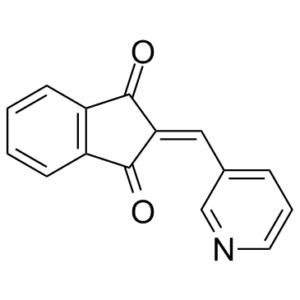PRT4165 (NSC-600157)
This product is for research use only, not for human use. We do not sell to patients.

For small sizes, please check our retail website as below: www.invivochem.com
| Size | Price | Stock |
|---|---|---|
| 500mg | $850 | Check With Us |
| 1g | $1250 | Check With Us |
| 5g | $3750 | Check With Us |
Cat #: V0083 CAS #: 31083-55-3 Purity ≥ 99%
Description: PRT4165 (NSC600157) is a potent and selective inhibitor of the PRC1 (polycomb repressive complex 1)-mediated H2A ubiquitylation with potential anticancer activity.
Top Publications Citing Invivochem Products
Publications Citing InvivoChem Products
Product Promise

- Physicochemical and Storage Information
- Protocol
- Related Biological Data
- Stock Solution Preparation
- Quality Control Documentation
| Molecular Weight (MW) | 235.24 |
|---|---|
| Molecular Formula | C15H9NO2 |
| CAS No. | 31083-55-3 |
| Storage | -20℃ for 3 years in powder formrr |
| -80℃ for 2 years in solvent | |
| Solubility In Vitro | DMSO: 11 mg/mL (46.8 mM)rr |
| Water: 4 mg/mL (17.0 mM)rr | |
| Ethanol: < 1 mg/mL | |
| SMILES Code | O=C1/C(C(C2=C1C=CC=C2)=O)=CC3=CC=CN=C3 |
| Synonyms | PRT4165, PRT-4165, PRT 4165; NSC600157; NSC 600157; NSC-600157 |
| Protocol | In Vitro | PRT4165 is a potent inhibitor of PRC1-mediated H2A ubiquitylation. In vitro E3 ubiquitin ligase activity assays reveal that PRT4165 inhibits both RNF2 and RING 1A, but not RNF8 nor RNF168. In the presence of PRT4165, H2A ubiquitylation can be completely inhibited regardless of whether RING1 or RNF2 contributes the E3 ubiquitin ligase activity. Treatment of cells for 60 min with 50 μM PRT4165 results in a dramatic reduction in total ubiquitylated histone H2A. It is also found that longer exposure of the cells with the PRT4165 (30 and 60 min) leads to increased levels of γ-H2AX in unirradiated cells. PRT4165 inhibits double-strand break (DSB) repair at the 8-h time point compare with mock treated cells. Cells treated with increasing concentrations of PRT4165 show increasing numbers of cells in G2/M |
|---|
These protocols are for reference only. InvivoChem does not
independently validate these methods.
| Solvent volume to be added | Mass (the weight of a compound) | |||
|---|---|---|---|---|
| Mother liquor concentration | 1mg | 5mg | 10mg | 20mg |
| 1mM | 4.2510 mL | 21.2549 mL | 42.5098 mL | 85.0196 mL |
| 5mM | 0.8502 mL | 4.2510 mL | 8.5020 mL | 17.0039 mL |
| 10mM | 0.4251 mL | 2.1255 mL | 4.2510 mL | 8.5020 mL |
| 20mM | 0.2125 mL | 1.0627 mL | 2.1255 mL | 4.2510 mL |
The molarity calculator equation
Mass(g) = Concentration(mol/L) × Volume(L) × Molecular Weight(g/mol)
Mass
=
Concentration
×
Volume
×
Molecular Weight*
The dilution calculator equation
Concentration(start)
×
Volume(start)
=
Concentration(final)
×
Volume(final)
This equation is commonly abbreviated as: C1 V1 = C2 V2
Concentration(start)
C1
×
Volume(start)
V1
=
Concentration(final)
C2
×
Volume(final)
V2
Step One: Enter information below
Dosage mg/kg
Average weight of animals g
Dosing volume per animal µL
Number of animals
Step Two: Enter the in vivo formulation
%DMSO
+
%
+
%Tween 80
+
%ddH2O
Calculation Results:
Working concentration:
mg/ml;
Method for preparing DMSO master liquid:
mg
drug pre-dissolved in
µL
DMSO(Master liquid concentration
mg/mL)
,Please contact us first if the concentration exceeds the DMSO solubility of the batch of drug.
Method for preparing in vivo formulation:
Take
µL
DMSO master liquid, next add
µL
PEG300, mix and clarify, next add
µL
Tween 80,mix and clarify, next add
µL
ddH2O,mix and clarify.
Note:
- (1) Please be sure that the solution is clear before the addition of next solvent. Dissolution methods like vortex, ultrasound or warming and heat may be used to aid dissolving.
- (2) Be sure to add the solvent(s) in order.




































